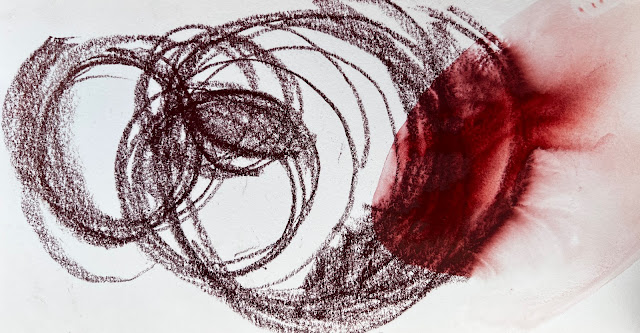.jpeg) |
| A walk through a garden gate |
Last Saturday, Bill and I attended a live podcast produced by Village Connect, a local non-profit with a mission to support families, schools, and individuals by developing cultural connections. The event was staged in a local church, which had been renovated with white walls everywhere, while still retaining the original stained glass windows that brought colored light into the room. It was a beautiful space.
I've spent many a Sunday throughout my life sitting in a church. I am not a religious person anymore, having given up Christianity when the extreme right took over back in the late 70s. I had to step back and examine my own beliefs when I repeatedly heard words and ideas that I didn't believe in. That doesn't mean that I have lost my love of churches. I find walking into one gives me a moment of stillness and quiet that I don't experience in a museum or other monumental place.
 |
| Angel in an old church in Norway |
We sat in comfortable padded chairs positioned so that each person had plenty of room to walk down an aisle or place their possessions around them. The back of each chair had two pockets: one for donations and one for a pamphlet about the church, but no Bibles or hymns. Sitting, while we listened to the podcast interviews, I thought of other seating in other churches in my life. As a child, my family attended a local Methodist church, which met in a small traditional Gothic-style chapel with stained glass windows lining the stone walls. The church was dark and lit by candles. The pews were wooden and hard. A pew-length pocket contained a hymnal, a Bible, and envelopes to put in donations when the brass plate came down the aisle. The rows of pews were close together, too close for people to easily pass by others, so an usher guided latecomers to the outside of the row, and the seated group would move inward. We would be touching each other as we sat. I liked leafing through the hymnals to read when each hymn had been written and by whom. I tried to stay as still as I could so I could continue to sit with my parents instead of going to Sunday school.
The church grew in the 60s and built a modern version with enormous stained glass windows over the altar and side walls, flooding the space with light. The pews remained the same, straight-backed hardwood, except they now had cushions. Bill and I were later married in the old chapel because I loved the traditional space and the organ music that enveloped the room.
As an adult, I attended a local church with a large congregation for a while, as well as various other churches when we lived in Tokyo and Paris. All of those churches had the same hard pews, and I imagined that those seats were made deliberately hard by the builders to develop discipline and humility. We visited churches such as Chartres Cathedral, where we arrived just as the organist sat down to practice, and the sound reverberated throughout the cathedral. We followed the purification rituals when we visited Buddhist temples and Shinto shrines, dipping the wooden cup offered into the clear, running water, pouring the water onto our hands, and rinsing our mouths before we turned to walk through the torii gate. We also removed our shoes before we entered the temple. In each place, we found wonder, beauty, and quiet spaces created by the builders.
 |
| A torii gate leading to a temple in Japan |
As I moved away from the church, I still found myself walking into churches in different locations, such as Carmel, where The Church of the Wayfarer's garden features plants and trees referenced in the Bible, and inside a dark, quiet space much like the church of my childhood.
In the last few months, I have attended memorial services for friends at churches that have made changes in the way people are seated. Padded cushions cover the pews of one church. Another had taken the pews out entirely and substituted individual chairs. Last Saturday, comfortable chairs filled the sanctuary. Instead of family and friends sharing the same tight, uncomfortable spaces, I now found a separate, comfortable place for each person. We weren't touching each other, nor did we need to make room for someone else. I wondered if the removal of the pews for individual seats reflected our own view of who we are and our place in this changing world.
Find out about the work Village Connect does here:
https://www.village-connect.org
Origins of the religious right:
https://www.politico.com/magazine/story/2014/05/religious-right-real-origins-107133/
Before you go to Japan, check out this site about purification rituals at Japanese temples and shrines:



.jpeg)
.jpeg)


.jpeg)




.jpeg)
.jpeg)
.jpeg)

.jpeg)
.jpeg)
.jpeg)


.jpeg)


.jpeg)


.jpeg)